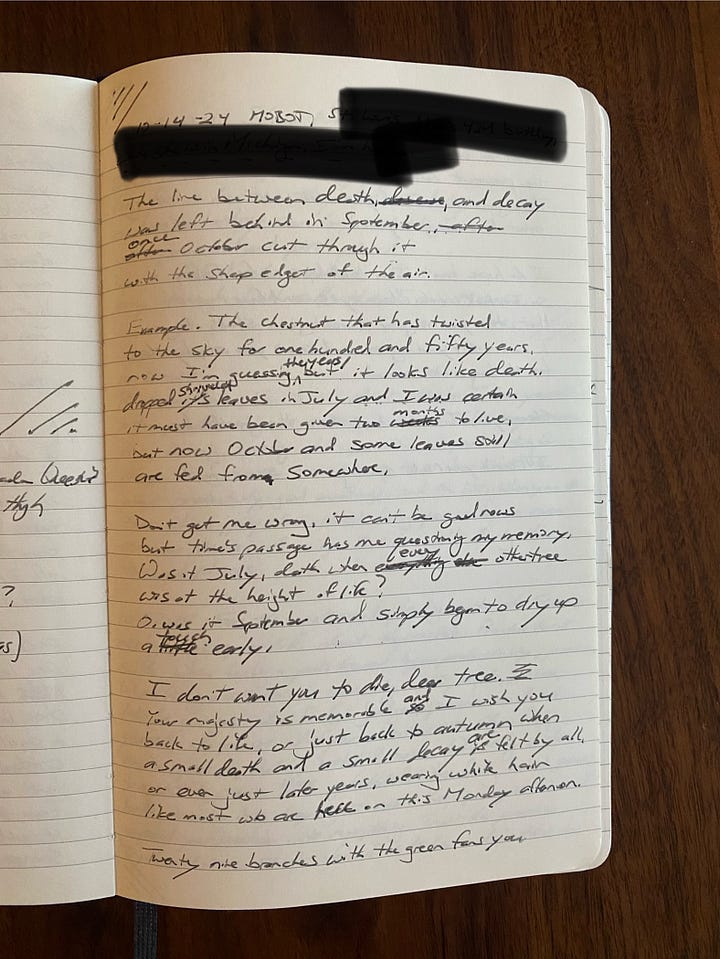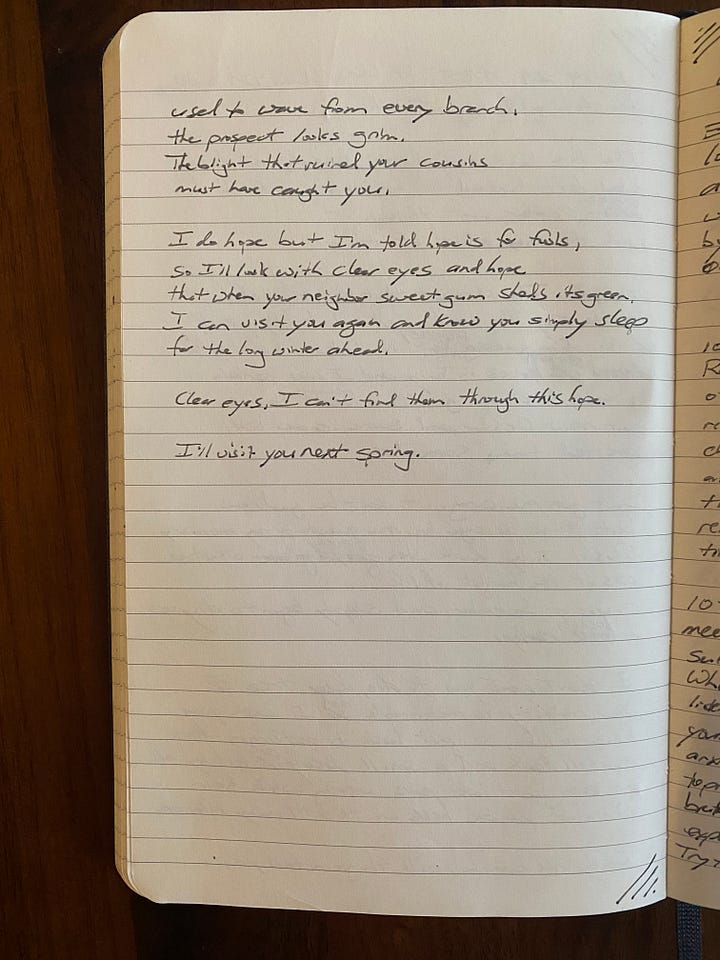This poem was written as part of the Garden Walks project. It was the second poem I wrote in this manner and the second that I have published on Poetry & Process.

Clear eyes and hope is a poem that walks through the muck of melancholy and the early denial of grief through an exploration of hope. While the poem wanders, I wrote the first draft while sitting still on a bench facing a chestnut tree at the Missouri Botanical Gardens. It was mid-October, which in Missouri is typically approaching peak autumn color. Some leaves had begun to fall but most still clung to the trees with stunning color.
A chestnut caught my eye as I approached and brought me to a pause. The tree appeared rough in a way that raised an alarm. I recalled noticing earlier in the year, while on a walk in late summer that this tree’s leaves were beginning to dry, and while I’m not a chestnut expert it seemed odd. Then on this October day, while there were a handful of branches that still had green leaves that looked bright and healthy, they were contained to one quarter of the tree, while the rest was already bare and seemed to be oozing decay from the tips of its branches.


Theme
Every emotion can arise when approaching loss. When I recognize something is about to go awry, I’m met with a meld of denial for what may come, grief for the situation at hand, guilt for my role, and hope that what I want will come to pass.
This complexity, all under the lens of hope, is called to the stand in Clear eyes and hope.
Our culture typically looks at hope as a positive emotion. It represents a willingness to believe that things can change for the better, which is often seen as the first step in participating in a change. This is certainly a valid point of view, as we clearly see when we look at changes that have occurred over time. Hope for equality led to the end of slavery and to the accomplishment of women’s suffrage. Hope for a just society led to the formation of America, an experiment of democracy, and a legal system with checks and balances. Hope for a better life for their children leads parents to put aside their personal needs to set their children on stronger footing than they had when they set out into the world as young adults. Hope is a trait that in its ideal state leads to progress, change, and betterment of the external.
The question arises, what does hope do for our internal world? Over the past few years, I have heard it said that hope leads to suffering, especially from western teachers who have a leaning toward eastern practices and spirituality. Eastern wisdom traditions teach that we already have a deep source of peace and wisdom inside of us that can be touched at any time, therefore hope can cloud what is already clear and fuel the cycle of samsara. This view is very logical, to the point where I agreed for a period of time. The logic is that if you carry hope, you are reaching for something out of your control that will often not come to pass, and therefore leave you discontent. If you hope, you will be restless, therefore losing your equanimity. If you hope, you may desire a certain outcome and even if you arrive, you will become just as dissatisfied as you were as desire raises its head again.
Logically, it thinks right, but this idea has not felt right to me. The idea of hope seems foundationally human, and if it can change the external world, it feels right that it can also positively impact our internal. Perhaps the question to consider is if these conclusions are not attributable to hope, but to other emotions or beliefs that are mislabeled as hope in our inability to honestly assess circumstances. It is the encroaching traits that emerge throughout this poem, all under the guise of hope. Let’s explore a few… denial, desire, and delusion.
Don’t get me wrong, it can’t be good news
but time’s passage has me questioning my memory,
was it July, death when every other tree
was at the height of life,
or was it September and simply began to dry
a touch early?
In this stanza, one’s memory is questioned to try to ease the potential pain of the situation. The author knows it was the height of summer when this tree began to wilt yet tries to convince himself otherwise. This is not hope. It is denial.
I don’t want you to die, dear tree.
Your majesty is magnificent and I wish you
back to life, or just back to autumn when
small death and small decay are felt by all,
or even just back to later years, wearing white hair
like most who stare this Monday afternoon.
This stanza pleads for the situation to be different than it is, the tree to be restored to the height of its glory, or almost as if in a negotiation just back to a time prior to its imminent demise. This is not hope. It is desire.
I do hope but I’m told hope is for fools,
so I’ll look with clear eyes and hope
that when your neighboring sweet gum sheds its green,
I can visit you again and know you simply sleep
for the long winter ahead.
Next, an honest assessment of the situation, coming back to the facts at hand, followed by a disparaging statement towards oneself to shake himself into what he knows to be true. But even in one simple line of a stanza, pure hope is lost, and a new trait enters, using the passage of time and neighboring circumstances to see things differently. This is not hope. It is delusion.
The poem ends in tension. Clear eyes, I cannot find them through this hope. // I’ll visit you next spring. This stanza does not declare honesty and hope cannot exist simultaneously. In fact, hope is at its best when it is side by side with an honest assessment of a situation. Seeing the current state clearly with a layer of hope can be the driver to the work of change that I referenced at the beginning of this essay, a place that carries actual possibility. This stanza is a declaration that one is simply not ready for this place. They currently wrestle with the underlying traits we discussed, and perhaps the passage of time will bring them to a place where clear eyes and hope can live simultaneously.
Final thought
To claim there is no hope is cynical. To think everything is possible is naive. The difficult practice is to hold hope and honesty together. There is an open space here where beauty and equanimity can emerge.
May you have clear eyes and may you also have hope.
Brian
If you missed the original “A Poem” post of Clear eyes and hope, I hope you will read and enjoy! You can find it here.




I like your thoughts on hope & honesty, Brian. I think sometimes the hope that is taught and championed is actually greed for a situation and conditions to be brought about. Greed can masquerade itself well as hope. Hope for a better life, society, etc. Thank you for sharing.
Brian, I appreciate your thoughts this morning. The open space—the place between cynicism and naivety— is an important place to explore right now. I find myself wanting to inhabit this place, at least in some way, on a daily basis. It seems urgent right now. I notice for myself, the insistent impulse to create something beautiful—not out of naivety—but as an act of defiance of the encroaching darkness of this era. Thank you for sharing your thoughts with this poem and its reflection.